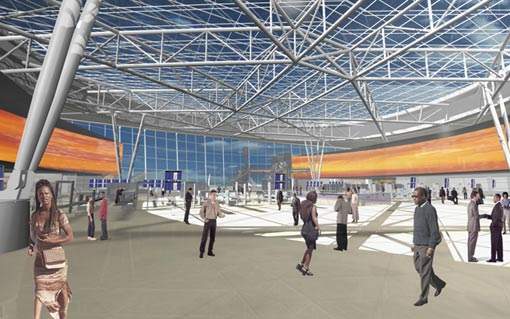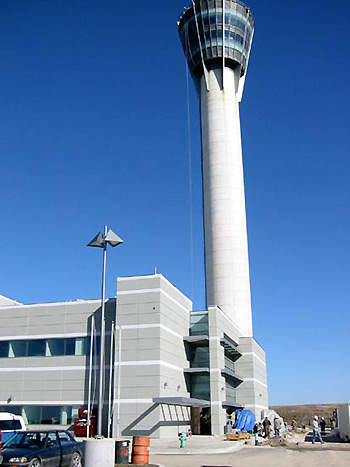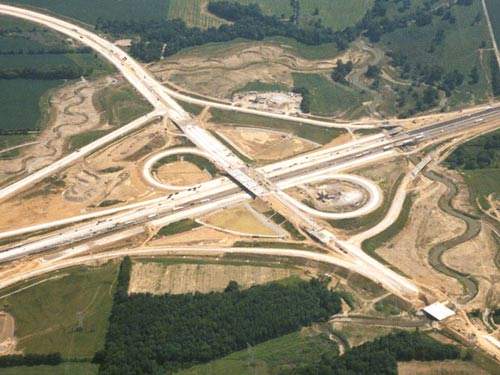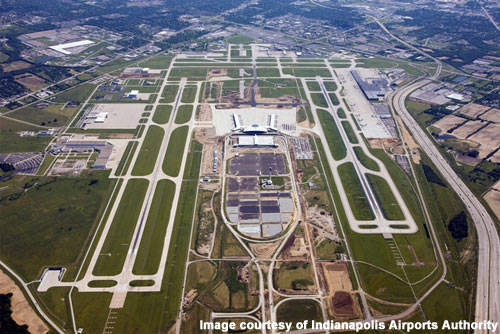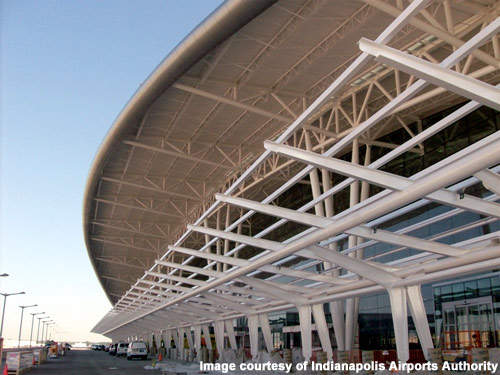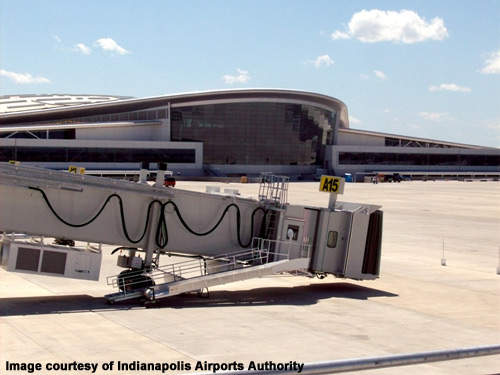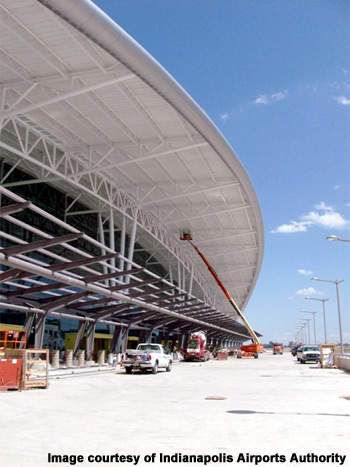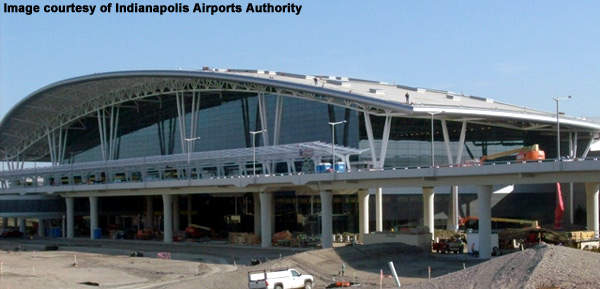In 1992 a study commissioned by the Indianapolis Airport Authority (IAA) confirmed the need for a new midfield terminal complex. In 1996, the annual passenger volume exceeded seven million for the first time, and the following year a new Terminal Master Plan Update for the airport put forth a new terminal project, in preference to expanding the existing terminal.
The project was known as ‘The New Indianapolis Airport’, rather than an expansion, as it really is a new airport – with a new terminal, in a new location, with a new car park, and even new access roads.
Construction on both the new terminal building and a new control tower began in 2003. The control tower was opened in April 2006 and the terminal building was opened on 11 November 2008.
Many major airlines such as Air Canada, AirTran, American Airlines, Continental Airlines, Delta Airlines and Frontier Airlines operate at the airport. Midwest Airlines, Southwest Airlines, United Airlines and US Airways are the other airlines operating at the airport.
Funding
The project cost is estimated at $1.1bn. Airport revenues paid most of the costs through a combination of Federal grants, passenger facility charges, airline rental and landing fees. No state or local tax money is being used to finance construction.
In November 2004, the IAA Board sold more than $221m of 30-year bonds. Money raised was used to fund construction of portions of the new airport, including the new FAA tower, access roads, apron grading and paving.
BAA Indianapolis LLC, a wholly-owned subsidiary of BAA plc, was selected by the IAA in 1995 to manage the Indianapolis International Airport, among other airfields within the State of Indiana.
Contractors
In 2002, St. Louis-based HOK was selected as the master design firm. A further nine companies were also contracted to perform construction manager duties. Indianapolis-based Hunt Construction Group, along with Turner Construction Company (Dallas), were appointed primary construction managers. The other construction companies were Smoot Construction (Indianapolis), Trotter Construction Company, Inc. (Indianapolis), GM Construction, Inc. (Indianapolis), Powers & Sons Construction Company, Inc. (Indianapolis), Harmon Construction, Inc. (North Vernon, IN), and Shiel Sexton(Indianapolis).
Other contractors included: Syska & Hennessey, Inc. and Thornton-Tomasetti Engineers (mechanical and structural engineering); BSA Life Structures and Blackburn Architects (owner’s technical representatives); Hanscomb (cost estimating); Leigh Fisher Associates (financial planning); Gibson and Associates, LLC (business outreach / diversity program coordinator); Executive Media (communications).
Projects
Construction projects completed at the airport included:
- New terminal building
- New air traffic control tower (ATCT)
- Relocation of a portion of Interstate 70 which, provided new access from near the junction of the I-465
- New five storey parking garage (5,900 cars and 1,200 rental cars)
- About 18,000 parking spaces under cover and on the surface
- New 250-room hotel
New midfield terminal
The New Indianapolis Airport features a modern 1.2 million-square-foot terminal built in the midfield area of the present airport, between the two main runways (two 20-gate concourses A and B). The heart of the terminal building is a Civic Plaza, a central gathering point representing the circular shape of the city’s central public space, Monument Circle. In addition to serving the necessary security and concessions functions, the plaza incorporates artwork, provides public event space and enables visitors to sample the character of Indianapolis and the region.
The new terminal features more than forty new and returning national brands, including Starbucks, McDonalds, CNBC, Brooks Brothers, Harley-Davidson, Borders, Pacific Outfitters, Au Bon Pain, Qdoba, Brookstone, Johnston & Murphy, and Cold Stone Creamery. The dining and shopping centre of the airport is the Civic Plaza, which offers approximately 25,000ft² of restaurants and retailers.
Each of the two concourses has approximately 15,000ft² of retail space.
The terminal features the first Indianapolis 500 Grill, a sit-down restaurant, which is also accompanied by a Brickyard Authentics apparel, a collectibles store and an Indianapolis 500 museum.
Cultural Crossroads is a comprehensive local museum store offering merchandise from eight of Indianapolis’s leading museums and cultural institutions including the zoo and the museum of modern art. There are many places to eat at the airport including: Harry & Izzy’s restaurant in concourse A, Patachou on the Fly (a bistro), Shapiro’s, Indy’s famous kosher-style delicatessen, King David Dogs, 96th Street and Giorgio’s Pizza Steakburgers.
The terminal roof is shaped to create a symbolic threshold to the city and state, emanating from the Civic Plaza. The form is generated by joining the sheltering, centralized shape of an arch with the rise and fall of the building from check-in to departure. The arched roof shelters the glass walls from the sun and allows sunlight through the skylights. The arching promotes natural cooling; by harnessing the airflow over its surfaces, the roof surface reflects energy, limits heat gain and channels water for collection. Encompassing high glass walls, the building rises over the plaza to reveal a view of the aircraft apron and the city skyline.
The midfield terminal site is on greenfield land which had been reserved for the airport’s expansion since 1975. The plot is nearly a mile wide and over two miles in length.
Landside development provides roadway access, utilities distribution, vehicle parking, support facilities and commercial development areas for the terminal complex.
The airside development of the new airport provides the aircraft parking, access to the runways and aviation support facilities. The midfield layout facilitates the efficient movement of aircraft. Connector taxiways align with existing exit taxiways to provide the shortest and most direct route to aircraft gates, thereby reducing taxiing time.
The new terminal has 96 passenger check-in counters and two 20-gate concourses with room to expand these further when required. Each of the concourses reserves one gate at the end for international flights (2007 saw 30,000 international passengers out of 4.1 million deplaning). The international arrivals area is a separate 24,250ft² area with baggage handling, immigration and a centre for disease control (total 17 staff).
Runways
The airport has two parallel runways (5L/23R and 5R/23L) and a crosswind runway (14/32).
Air traffic control tower (ATCT)
The ATCT was built as a joint venture between Hunt Construction Group and Smoot Aviation Contractors (Columbus, Ohio). Built at a cost of $32 million, it is one of the tallest in the US at 340ft tall. Included in this cost is a new two-story Terminal Radar Approach Control (TRACON) facility.
The shaft of the ATCT is 28ft in diameter, with 18in-thick concrete walls. The cab structure above the shaft accommodates nine air traffic controller positions. From here, the air traffic controller has an unobstructed, 360°, 5-mile-radius view – the glass window panels are joined using silicone sealant, as there are no supporting columns that obscure sections of the airfield.
It was designed by Teng & Associates of Chicago.
Interstate 70 (I-70) relocation
In October 2002 work began to relocate a portion of Interstate 70 (I-70). At a cost of $170 million, the Indiana Department of Transportation (INDOT) project included a dedicated I-70 interchange to serve the new airport and a new Six Points Road at I-70 interchange. The project was completed in December 2004, with the official opening taking place on 29 December 2004.

